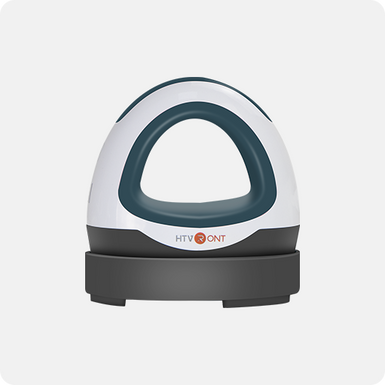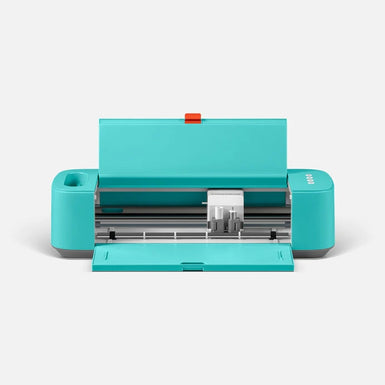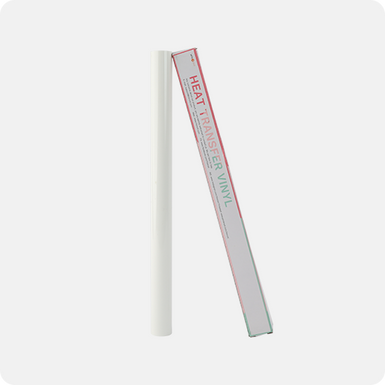When making vinyl crafts, beginners often have this question, should I use heat transfer vinyl or adhesive vinyl? Actually the answer depends on the purpose you want to use.
In this article, I will tell you the difference between adhesive vinyl and heat transfer vinyl, and share with you what they are used for!
Part One: An Introduction to Heat Transfer Vinyl
1.1. What is Heat Transfer Vinyl?
What's HTV vinyl? Heat transfer vinyl or HTV is applied to T-shirts and other substrates by heating. You may have many T-shirts and other clothes with HTV! You can use a heat press or a household iron for heat transfer. Heat transfer vinyl for shirts can make many amazing craftings!
HTV vinyl is divided into two parts with htv sheets and rolls. There are vinyl and carrier sheets. They are all joined together and separated during heat transfer. The quality of the vinyl will determine the ease of your project and the quality of the customized T-shirt. It is best to match with high-quality heat transfer vinyl of well-known brands such as HTVRONT, otherwise you may waste a lot of materials.
1.2. What can You Apply Heat Transfer Vinyl onto?
What is htv vinyl used for? Heat transfer vinyl is most commonly used for T-shirts. You can press it on many surfaces! You can press HTV on T-shirts, masks, sweatpants, baby and children's clothing, sweatshirts, hats, footwear, wooden farmhouse signs, swimsuits, tea towels, canvas tote bags and more!
If the HTV is correctly pressed on the clothes, it will adhere well to the clothes and can be washed multiple times. Adhesive vinyl cannot be used for clothing. It's like putting a label on your T-shirt. Therefore, it is always best to use HTV for clothing and fabrics.
1.3. How to Use Heat Transfer Vinyl?
This is what you need to use heat transfer vinyl and make your own T-shirt:
1) Cutting Machine;
2) Weeding tool kit;
3) Iron or heat press;
4) Teflon sheet or parchment paper to protect the hot plate or iron.

This is a simple example of how to make an HTV design.
1) Choose a free font and arrange the text.
2) Because HTV is applied in reverse, you need to mirror your image.
3) Put the HTV on the cutting mat, and then weed the design to be pressed.
4) Before pressing the design, pre-press any fabric to remove moisture and wrinkles. Put the heat transfer on the t-shirt, and then press it with an iron or heat press.
Read our article to learn How to Use Heat Transfer Vinyl.
Once the design is pressed onto the t-shirt, you can remove the vinyl carrier sheet. For most HTV (including Siser & Cricut), it can be peeled off while it's hot.
Part Two: An Introduction to Adhesive Vinyl
2.1 What is Adhesive Vinyl?
Adhesive vinyl is like HTV, except it is not heated, it is an amazing label! As with HTV, you can choose different types of adhesive vinyl. You can choose an adhesive with a temporary or removable adhesive, which is perfect for things such as wall decals. Most permanent vinyl adhesives you will find in production will have a gloss. This is not always the case, but in most cases, following this rule will ensure safety.
2.2 What can You Apply Adhesive Vinyl onto?
You can apply vinyl adhesive on these materials, such as walls, refrigerators, cars, cups and mugs, pots and vases, glass, tiles, etc. Adhesive vinyl is best for things that do not require washing or even a lot of handling (so definitely not clothes!). Can you use adhesive vinyl on shirts? The answer is yes. Read our article to learn adhesive vinyl beginner's guide.
It is best not to apply vinyl adhesive to rough or porous objects because it will not stick. For example, when applying vinyl adhesive to stretched canvas, it is best to apply a layer of acrylic paint or spray a clear coat on the canvas before applying the vinyl adhesive (make sure the paint is completely dry first). This will help the vinyl to adhere better. The same is true for wood, and you can also sand and dye it before applying vinyl.
2.3 How to Use Adhesive Vinyl?
This is what you need to make your own vinyl decal:
1) Cutting machine
2) Transfer tape
3) Weeding tool
You will need to cut the design in the cutter with the backing paper side down and the vinyl side up. Unlike HTV, there is no need to mirror the design before sending the design to be cut.
The process is as follows:
1) Cut your design into vinyl
2) Remove excess vinyl
3) Put the transfer tape on top of the vinyl glue and sand it
4) Pull the sticker
5) Application transferred to the surface and sanded
6) Remove the transfer paper and leave only vinyl on your project
Read our article to learn how to use adhesive vinyl.
Part Three: The Difference Between HTV and Adhesive Vinyl
3.1 Should You Use HTV or Adhesive Vinyl?
Heat transfer vinyl is always the best choice for clothing and fabric items (such as handbags, cosmetic bags, drink coolies, mouse pads, etc.). The use of heat makes the design adhere firmly to the substrate, making it more durable.
Adhesive vinyl is very suitable for awkward objects that cannot transfer heat. Overall, vinyl adhesives can provide more functionality with things you can create something suitable for making wall art or decorating things such as glass cutting boards!
3.2 How to Tell the Difference?
HTV is significantly different from adhesive vinyl. Since you cut the HTV from the side opposite to the vinyl glue, it will be located on a transparent or opaque plastic carrier board, which serves the same purpose as transfer tape. Custom-printed HTV may not have carrier paper, and usually the carrier paper must be used separately to perform the printing process. A hint might be to write text on the back of each piece of paper, use a knife on the HTV or write a label on a small piece of paper. If you do, please be careful not to transfer it to a Teflon board or hot press board and carry it on to other items!
3.3 Pros of Heat Transfer Vinyl
When used on canvas, wood, ceramics, etc., it is more durable and lasts longer. HTV is more suitable for commercial use - if you want to sell quality products, then HTV will bring better results.
3.4 Pros of Adhesive Vinyl
It may be cheaper than using HTV, because you need less equipment. Apply adhesive vinyl to awkward surfaces such as wine glasses. You cannot do this with a heat press! Easy to apply to outdoor surfaces such as vehicles. Compared with HTV, it is faster and simpler to use. You don’t need to buy a heat press or learn how to use it. After cutting the design, you can easily apply it by hand.
I hope you now have a better understanding of when to use HTV and when to use adhesive vinyl. As you can see, using each method has advantages and disadvantages, depending on the project you are considering. You can consider which is more durable, which is cheaper, and which is best for the surface. What is your most recent project? What kind of vinyl did you use?












![[Starter Kit] Auto Heat Press Machine 15" x 15" 110V + Starter Kit Bundle](http://www.htvront.com/cdn/shop/files/21_080605f2-5363-49a8-87f9-98c73560a5e9_385x.jpg?v=1713344774)
![[Premium Bundle] Auto Heat Press Machine 15" x 15" 110V + 20 rolls HTV Bundle 12“x3ft + Mini 2 Heat Press Machine + Random Sublimation & HTV Bundle ≥ $180](http://www.htvront.com/cdn/shop/files/1UK_4_385x.jpg?v=1713340288)
















Customer Reviews
Great explanation of both. I am a beginner and was wondering the different between the two. Thanks again.😍